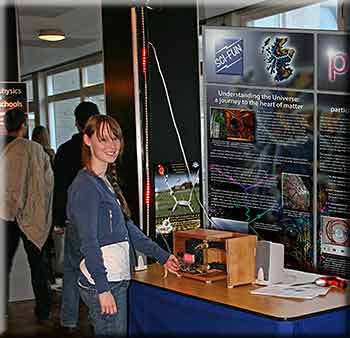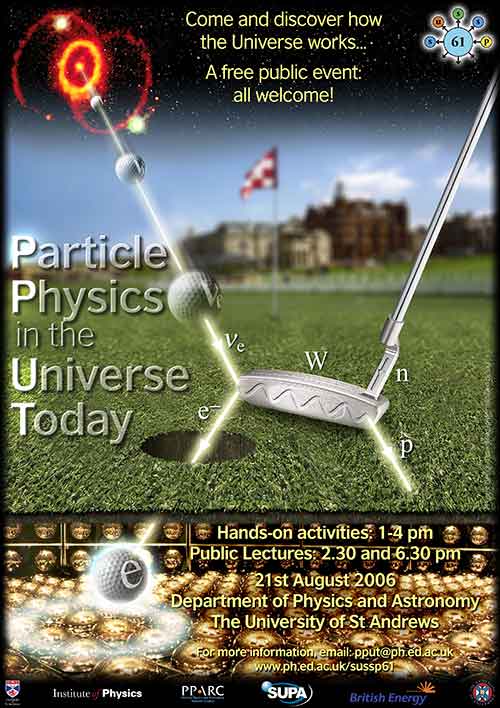|
Particle Physics in the Universe Today
|
| As part of the Scottish Universities Summer School in Physics, a free public science event was held at the Universities of St Andrews on August 21st. where school and family audiences found out all about neutrinos, tiny particles produced in stars that travel throughout the universe. (In fact, as you are reading this about 40,000 billion neutrinos produced in our sun are travelling through your body every second...) Professor David Wark from Imperial College in London gave a lecture on this fascinating particle, and hands-on demonstrations from the PP4SS group, including cloud chambers, cosmic ray detectors and accelerator simulators, were available for the public to view.
The photograph below shows Holly Batchelor from Mary Erskine's School in Edinburgh, standing beside the cosmic ray hodoscope – built and tested as part of her Nuffield Scholarship placement with PP4SS and SCI-FUN – during the afternoon PPUT session. Behind her is the particle track, which illustrates (with a stream of LEDs) the passage of each coincident particle through the detectors. [Note: since this was written, Holly completed her Nuffield placement, and has gone on to win several major awards. The particle track in the photograph has been incorporated into the cosmic ray doorway.] |
|
|
| The PPUT poster above is built around a stylised Feynman diagram, a method for performing calculations in quantum field theory, invented by American physicist Richard Feynman. We see here a neutrino (top left), which at the very top of the poster is seen to be emanating from the 1987 supernova in the Large Magellanic cloud, then travelling through space for around 168,000 years, oscillating between the different neutrino types as it travels.
Finally it arrives at Earth, and interacts via the Weak force (mediated by a W vector boson, shown as the wavy line) with a neutron in the water filling the Kamiokande-II neutrino detector in Japan (some of the photomultiplier tubes of which are shown at the bottom of the poster). The interaction causes one of the consituent down quarks in the neutron to convert to an up quark, thus causing the particle to become a proton (bottom right), and the (electron-)neutrino is converted into an electron (the golfball at bottom left). The newly-created electron is moving faster then light in the water-filled detector, and emits Cerenkov radiation (visible light), which spreads out in a conical wavefront, reaching the sides of the detector as a circular patch of light. The eleven neutrinos detected from SN 1987 A at Kamiokande-II (and other detectors) were the first ever detected from a supernova, and the observations were consistent with theoretical supernova models in which 99% of the energy of the collapse is radiated away in neutrinos. |


